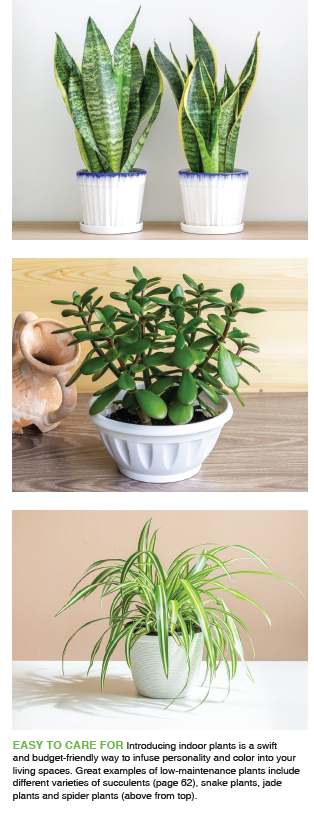As the chilly temperatures take hold and the lively blossoms of outdoor gardens diminish, there's no requirement to say goodbye to the allure of nature. Galveston, renowned for its distinctive climate, provides a chance to establish an indoor sanctuary with the assistance of houseplants.
Introducing indoor plants is a swift and budget-friendly way to infuse personality and color into your living space. Unlike other design elements, the best houseplants offer aesthetic appeal as well as health benefits, including a natural reduction in anxiety and stress levels.
“From my perspective, houseplants have an aesthetic beauty that benefit my sense of well-being and reduce stress. It is my attempt to bring the outdoors inside and provide a connection to the outdoor environment,” said Extension Agent-Horticulture at Texas A&M AgriLife Stephen Brueggerhoff. “The effect of houseplants on indoor air quality is minimal; the true benefit is to our sense of well-being.”
Despite being placed in a controlled environment, houseplants can still be impacted by stressors like dry air from home heating and reduced daylight hours, according to Brueggerhoff. Hence, it is essential to ensure a stable temperature and humidity for the optimal health of houseplants.
“Indoor temperature fluctuation can affect growth, cause leaf drop, or foliage damage,” he said.
While foliage and flowering plants thrive in temperatures that are generally comfortable for humans (around 75 degrees Fahrenheit during the day), it's important to note that foliage houseplants prefer slightly cooler conditions at night, around 65 degrees Fahrenheit. Flowering houseplants tend to do best when temperatures are 10 to 15 degrees lower than those preferred by foliage houseplants.
“In order to successfully maintain any houseplant, it is best to get to know the plant and research its growing conditions and to keep conditions consistent,” Brueggerhoff said, adding you don't need extensive gardening knowledge to maintain indoor plants.
“There are numerous easy-to-care-for options, such as succulents for well-lit spaces or trailing pothos for areas with limited sunlight.
The Jade plant and most succulents thrive in bright, indirect light. You may need to place them closer to a south-facing window or use a grow light. A general consideration for succulents is their ability to tolerate low ambient humidity, even as low as 30 percent.
 “You may have to rely on a few techniques to increase humidity in the immediate area of the plant, such as placing the containerized plant on a shallow tray filled with water and lava rocks,” Brueggerhoff added.
“You may have to rely on a few techniques to increase humidity in the immediate area of the plant, such as placing the containerized plant on a shallow tray filled with water and lava rocks,” Brueggerhoff added.
The rocks raise the container to prevent it from being submerged in water, avoiding over-saturation of the growing medium. This elevation also enhances relative humidity through the process of evaporation.
Brueggerhoff suggested that a humidifier be placed close to your plants and group together those plants that prefer higher humidity based on your requirements to make the most of the humidifier's placement.
“Even spaces with minimal natural light can accommodate low-light indoor plants like philodendrons,” he said. “The controlled conditions indoors often lead to better growth compared to outdoor environments.”
One such houseplant is the ZZ plant, “which grows in shady forests of southeastern Africa in more arid conditions in low light environment,” he said.
By contrast, the Spider plant will benefit from being placed next to a window, “and it responds well to higher humidity and will require weekly check on water.”
Galveston County Master Gardeners offer Gulf Coast Gardening seminars that focus on home gardening and horticulture. This winter, take advantage of the opportunity to plant trees with the upcoming seminar on tree selection for the home scheduled for the morning of February 10.
Explore insights on choosing the right tree for your landscape, understanding the optimal planting location, receiving maintenance tips, and delving into best practices for tree planting.
Additionally, the Vegetable Garden Series offers valuable sessions, starting with preparing the working garden with Spring Vegetables on the afternoon of February 10, followed by a session on Irish Potatoes on February 17 in the afternoon.
The Galveston County AgriLife Extension classrooms are located at 4102-B Main Street in La Marque. For more details and to register, visit www.txmg.org/galveston.
To begin your indoor plant collection, Brueggerhoff suggests starting with the following houseplants that are all easy to maintain.
Jade Plant (Crassula ovata) Requires medium light for a few hours daily and waterings every few days after the soil dries. Ideal for vibrant pots.
Snake Plant (Sansevieria trifasciata) Tolerates low light and low humidity and will not require frequent watering. Let it dry out between waterings.
Spider Plant (Chlorophytum comosum) Thrives in bright, indirect light with occasional waterings. Showcase in a hanging planter to highlight its curved leaves.
ZZ Plant (Zamioculcas zamiifolia) Thrives in bright to moderate, indirect light, but will do fine in extremely low levels of light. Water only when the soil has dried out. Easy to moderate to maintain.
Succulents, various
Thrives in full sun, so place near a source of natural light. Water once a week or two. Do not overwater. Place where they can get direct sun exposure or bright indirect light.